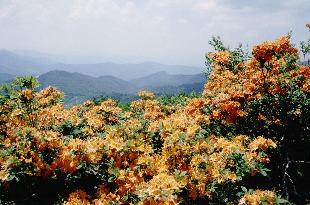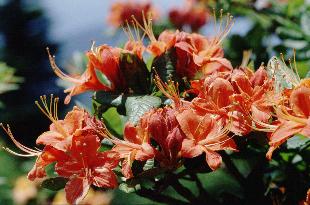


Next: References
Up: Best of the Best:
Previous: The Hybrid Swarm on
 We often hear environmentalists voicing concerns over the destruction of the rain forests in remote regions of the world, but we must realize that the rich biological diversity here in our own eastern forests is also at risk. We constantly upset nature's balance, yet we are often unaware that we have done anything wrong. We build roads, malls, shopping centers, and new homes in the name of progress, yet replace the rich native flora with masses of ordinary plants such as Leyland Cyprus or Bradford Pears. We must not lose the beauty and diversity that has evolved in our eastern forests over millions of years by using mass-market substitutes for the richness that was once all around us.
We often hear environmentalists voicing concerns over the destruction of the rain forests in remote regions of the world, but we must realize that the rich biological diversity here in our own eastern forests is also at risk. We constantly upset nature's balance, yet we are often unaware that we have done anything wrong. We build roads, malls, shopping centers, and new homes in the name of progress, yet replace the rich native flora with masses of ordinary plants such as Leyland Cyprus or Bradford Pears. We must not lose the beauty and diversity that has evolved in our eastern forests over millions of years by using mass-market substitutes for the richness that was once all around us.
As members of the Azalea Society, we must protect our native azalea heritage, not only the many species we admire but also the special places where these plants grow. We need to identify the best forms of our native azaleas, propagate them, and distribute this plant material to arboreta and commercial nurseries so that rare and superior forms are not lost forever. We also need to encourage commercial sources to propagate the natives and make them widely available so that there will be less pressure to steal plants from the wild. The general public is beginning to become aware of the native azaleas and will be looking for places to buy them.
 We certainly must not forget that there is a very delicate balance in nature. Environmentalists of all kinds must look for solutions to the burgeoning populations of deer and other destructive animals that are colonizing as rapidly as we are. They pose a risk not only to our suburban gardens but also to many rare plants in wilderness areas that we don't often see. Technological advances allow us to travel easily around the world,
but we often bring back with us foreign pests that become plagues in our local regions. We must be extremely careful to not introduce such pests or diseases into native populations for they could devastate our native azaleas. How sad it would be if petal blight became established in the Appalachian Mountains, melting the glorious azalea display just as it opened.
We certainly must not forget that there is a very delicate balance in nature. Environmentalists of all kinds must look for solutions to the burgeoning populations of deer and other destructive animals that are colonizing as rapidly as we are. They pose a risk not only to our suburban gardens but also to many rare plants in wilderness areas that we don't often see. Technological advances allow us to travel easily around the world,
but we often bring back with us foreign pests that become plagues in our local regions. We must be extremely careful to not introduce such pests or diseases into native populations for they could devastate our native azaleas. How sad it would be if petal blight became established in the Appalachian Mountains, melting the glorious azalea display just as it opened.
 There is much more to our native azalea heritage than an occasional orange flower in someone's garden or a glimpse of color along the Blue Ridge Parkway. We need to educate the general public so that others appreciate the wonderful diversity that exists in nature. They must also become stewards of our cause. If we can teach others to see the beauty that we see, perhaps there is a chance to preserve such treasures for future generations to enjoy. Mankind has been the cause of much destruction, but through education we can also bring a cure.
There is much more to our native azalea heritage than an occasional orange flower in someone's garden or a glimpse of color along the Blue Ridge Parkway. We need to educate the general public so that others appreciate the wonderful diversity that exists in nature. They must also become stewards of our cause. If we can teach others to see the beauty that we see, perhaps there is a chance to preserve such treasures for future generations to enjoy. Mankind has been the cause of much destruction, but through education we can also bring a cure.



Next: References
Up: Best of the Best:
Previous: The Hybrid Swarm on
Donald W. Hyatt
2001-06-26
 We often hear environmentalists voicing concerns over the destruction of the rain forests in remote regions of the world, but we must realize that the rich biological diversity here in our own eastern forests is also at risk. We constantly upset nature's balance, yet we are often unaware that we have done anything wrong. We build roads, malls, shopping centers, and new homes in the name of progress, yet replace the rich native flora with masses of ordinary plants such as Leyland Cyprus or Bradford Pears. We must not lose the beauty and diversity that has evolved in our eastern forests over millions of years by using mass-market substitutes for the richness that was once all around us.
We often hear environmentalists voicing concerns over the destruction of the rain forests in remote regions of the world, but we must realize that the rich biological diversity here in our own eastern forests is also at risk. We constantly upset nature's balance, yet we are often unaware that we have done anything wrong. We build roads, malls, shopping centers, and new homes in the name of progress, yet replace the rich native flora with masses of ordinary plants such as Leyland Cyprus or Bradford Pears. We must not lose the beauty and diversity that has evolved in our eastern forests over millions of years by using mass-market substitutes for the richness that was once all around us.
 We certainly must not forget that there is a very delicate balance in nature. Environmentalists of all kinds must look for solutions to the burgeoning populations of deer and other destructive animals that are colonizing as rapidly as we are. They pose a risk not only to our suburban gardens but also to many rare plants in wilderness areas that we don't often see. Technological advances allow us to travel easily around the world,
but we often bring back with us foreign pests that become plagues in our local regions. We must be extremely careful to not introduce such pests or diseases into native populations for they could devastate our native azaleas. How sad it would be if petal blight became established in the Appalachian Mountains, melting the glorious azalea display just as it opened.
We certainly must not forget that there is a very delicate balance in nature. Environmentalists of all kinds must look for solutions to the burgeoning populations of deer and other destructive animals that are colonizing as rapidly as we are. They pose a risk not only to our suburban gardens but also to many rare plants in wilderness areas that we don't often see. Technological advances allow us to travel easily around the world,
but we often bring back with us foreign pests that become plagues in our local regions. We must be extremely careful to not introduce such pests or diseases into native populations for they could devastate our native azaleas. How sad it would be if petal blight became established in the Appalachian Mountains, melting the glorious azalea display just as it opened.
